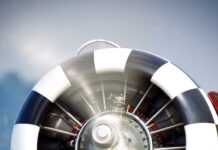Words of wisdom from veteran air show performers:
* Competition style loops and “air show loops” are not the same thing. Start your air show loop very fast. Then, as you begin the second quarter of the loop, release some of the back pressure so that you gain altitude and carve a nice even second half to your semi-circle in the air. As you hit the 180 degree mark (top) in your loop and begin the third quarter of your loop, your initially high airspeed as you entered the maneuver and your proper management of the second quarter of the loop will put you higher than a normal “competition style” loop which should allow you to recover with very little G and high energy at the bottom. The goal of the “air show loop” is to “drive” the aircraft back to the starting point. You should never have to “pull to miss the ground” in a loop.
* Rolls on vertical downlines waste a lot of altitude and energy. If you are low on energy or altitude, DO NOT perform the roll on the vertical downline, even if it is on your sequence card. Utilize the straight vertical line to re-gain your target energy numbers.
* Don’t over-estimate your ability to respond properly when you’re in an inverted aircraft close to the ground…particularly in the event of “complications.” If a problem occurs when you’re inverted and close to the ground, until you’ve trained extensively or been in the situation many times, your instincts will tell you to pull when what you really must do is push.
* Know your numbers “on top.” Flight test your aircraft with various “over the top speeds” and commencing maximum performance recoveries. Then give yourself 20-30 percent additional altitude on top of that and make that altitude your minimum pull-through altitude.
* Don’t be afraid to abort or delete a maneuver. No one will ever know except you and your crew. Trust the announcer to do his job and make you look good.
* Take your time. The biggest pitfall for new and inexperienced performers is allowing yourself to be rushed, either during or prior to your performance. Never let a show producer or air boss rush you to “get on stage.” Your first obligation is to fly a safe show.
* Learn to say no. It’s important to be as accommodating and “user friendly” as possible when working with an air show, but don’t allow ground commitments or unreasonable/last second requests to interfere with safety.
* Fill up if the fueler/smoke oil truck show up after your performance. It will save time and take pressure off your crew the next morning when things are probably more hectic.
* Make sure your show day schedule leaves enough time between performances if you are scheduled to perform more than once. You need time to service your aircraft and yourself, so don’t let yourself be rushed. A ten-minute window is unrealistic and unsafe.
* Take time to watch a performer or two before you fly to help gauge wind and show conditions. If time permits, try to get a short debrief from that pilot and be willing to share your in-flight observations with fellow performers.
* Pre-cool your parachute for at least an hour prior to your act by putting it in an air-conditioned vehicle.
* Videotape your practice session whenever possible. Some maneuvers that may seem spectacular from the cockpit may not look like much from the ground. Conversely, simple maneuvers can often be quite entertaining.
* Prepare a one-page safety sheet on your aircraft showing, as a minimum, egress points, fire extinguisher locations, safety harness details, fuel tank capacities and locations (along with fuel system details), battery location, jack and tow points and other unique features of the aircraft that might impact safety.
* Keep a single booklet in which you carry all your air show-related documentation (aerobatic competency card, medical certificate, airworthiness certificate, aircraft registration, insurance information, aresti chart, etc.) Keep it in your flight bag and bring it with you to morning safety briefings for review by the FAA or Transport Canada inspectors. Saves time. Easier to access the required information. Never any question in your mind where to find the needed documents.
* Have a designated crew member play “interceptor” for you as you are preparing to perform. Have them intercept the folks that may be a distraction during walk through and mental preparation.








